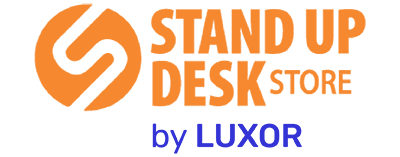How to Make Your Workspace More Productive
It’s no secret that for most people, a cluttered and disorganized desk can diminish productivity.
Here at Stand Up Desk Store, workspace optimization is a bit of a passion of ours. That's why in previous blog articles, we’ve written about the following:
- Healthy workspace tips
- Cleaning and disinfecting your workspace
- Setting up your desk and chair for ergonomics and correct posture
- Optimizing your workspace for better concentration
This month, we’d like to talk about how to set up a workspace that inspires productivity.
How to Make a Productive Workspace
1. Promote Healthy Movement
Sitting in a static position all day can make you sore, sluggish, unhappy, and definitely not productive.
Naturally, as a standing desk company, we’re big proponents of adjustable height desks that keep you moving by letting you quickly and easily transition between sitting and standing (we recommend at least five minutes of standing each hour).
But you don’t have to stop there. To create additional opportunities for movement, you can:
- Place your notepad away from your computer so you have to shift positions to jot something down.
- Keep your phone on a raised platform that requires you to stand up when you want to take a call.
When you have tasks that don’t require dual monitors, walk your laptop to a common area (like a breakroom) to work for a while.


2. Create an Efficient Workflow
In the culinary world, chefs use the term “mise en place” (French for “putting in place”), which entails arranging ingredients and cooking utensils in a logical order. When mise en place is executed correctly, the chef can be more efficient because everything is within easy reach, and one task flows naturally into the next.
Even if you don’t know how to cook, you can benefit from this principle in your workspace. A simple example would be keeping your sticky notes next to your pens, so you don’t have to retrieve items at opposite ends of the desk to write a note.
To create an efficient workflow at your desk, start by taking stock of your desk, the items you use on a regular basis and the tasks you commonly use the items for. Then, choose the best location for each item to optimize the efficiency of each task.


3. Personalize Your Workspace
When many of us worked from home during the pandemic, it was easy to feel at home. Now that many have been called back to the office, the comforts of home had to be left behind.
Personalizing your workspace with things you love will never be a replacement for your plush couch, but it can help you feel a little more at home.
So, while you can’t take your cat to the work, you should definitely bring in photos of friends and family, a houseplant, and a few carefully chosen decorative items.
These may seem like little things, but they can make a big impact on your mood and, in turn, your productivity.


4. Make Yourself Comfortable
Your employer is responsible for creating an environment that is agreeable to the widest range of employees.
Unfortunately, that “middle of the road” thermostat setting will inevitably make some feel constantly hot and others constantly cold. And the one size fits all office chairs may be ok for most but could be downright painful for a few outliers.
In short, it’s hard to be productive when you’re uncomfortable. So, if you’re an outlier, it’s ok to modify your personal environment. For example:
- Put a fan on your desk if you’re typically hot.
- Bring a blanket or an extra sweater if you tend to feel cold.
- If the office is too dim, use a desk lamp.
- If the standard issue chair is not to your liking, ask for a different one or install some gel cushions.


5. Leverage “Analog” Tools that Make Your Job Easier
Thanks to laptops, tablets, and smartphones, pretty much any conceivable organization and productivity tool is a mere download away on an app store.
And while digital tools are certainly helpful, they can, at times, be complex to the point where they inhibit efficiency more than they enhance it.
That’s why many may prefer to incorporate a couple of tangible, three-dimensional tools that can be used in the real world, don’t require a password, or force the user to scroll through a bunch of menus to access them.
Examples can include:
- A whiteboard for ideation and LEAN initiatives
- A notepad or stack of stickies for writing down important details
- A paper calendar for seeing the day and week at a glance
- An analog desktop clock to quickly keep track of time
- An old-school cassette recorder for taping important conversations and verbal notes


We hope you found these ideas helpful. For additional resources, we invite you to check out our:






